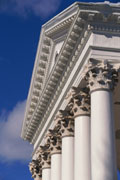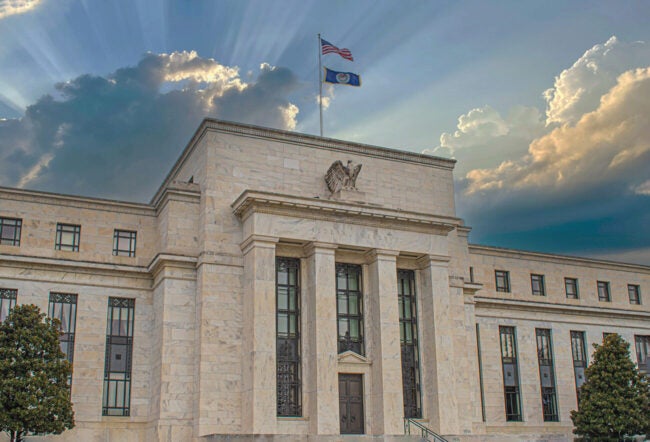The terrorist attacks that obliterated the landmark World Trade Center towers shattered steel and glass along with the confidence of workers who once found delight and prestige in spectacular high-rise views. But America’s signature skyscrapers, and the dense cities that spawn them, will remain a part of the landscape, Wharton faculty and real-estate industry executives say. Lower Manhattan lost more than 10 million square feet of space when the towers fell in the Sept. 11 terrorist attacks, nearly 10% of the entire financial district. Dozens of other buildings are damaged, and it will take six months to a year just to clear the rubble. Larry Silverstein, who heads the investment group that signed a 99-year lease on the World Trade Center complex in July, already has begun to engage architects and planners, and is considering a plan to redevelop the site with four 50-story buildings and a memorial to those killed. “There was a small earthquake there when those two towers fell,” said
While the site is redeveloped, a process that could take two to 10 years, tenants will need to relocate, at least temporarily. “The big tenants are having real trouble housing their people in a single spot because there just aren’t big swaths of space,” said Gyourko. “Some will find space in midtown. Some will go to New Jersey. The question is, ‘After they are settled, do they want to come back or will they stay in cheaper space in New Jersey?’”
Lizanne Galbreath, managing partner of Galbreath & Co., the Connecticut real estate firm, said many will never return. With new communications technology, the need to be at the heart of a business center is diminishing, although some people will always need to be there, she said. “Once they are in New Jersey people will realize the cost of office space is less and, more importantly, a lot of people will realize it’s efficient and it’s effective.”
Despite the tragedy that occurred there, the site is too valuable to lie fallow, real estate experts say. “It would be nice to put a park where the World Trade Center was but I’m not sure in reality that could ever happen,” said Galbreath.
Big buildings will someday rise on what is now rubble and ash, though not necessarily super-tall structures like the 110-story twin towers, suggest observers. “I don’t think we will see the World Trade Center replicated,” Gyourko said, “but to think that we’re all going to go to the suburbs in small buildings is not realistic.”
“There are very powerful economic forces that lead us to have big building in cities and they haven’t gone away,” Gyourko added. Massing workers together allows for savings on transportation, communication and construction costs. And there are also less tangible reasons for maintaining tightly packed office districts. “There is a spillover in ideas around dense concentrations,” he said.
William Mack, managing partner of Apollo Real Estate Advisors, L.P. in New York and chairman of Mack-Cali Realty Corp., characterized the events of Sept. 11 as a “defining moment for real estate. The tragic attack and destruction of the World Trade Center and the collateral damage that has occurred shows just how vulnerable cities were to terrorism.”
Mack suggested that cities will endure, but more corporations will now seek out more diverse locations within a city, or a region, so their operations are not all locked into the same building, neighborhood, or energy grid. “Eventually people will forget and get back to business as usual,” he said. “But there will be more contingency planning for diversity.”
As a result, Mack expects suburban leasing will be somewhat stronger than it might have been otherwise and companies with significant operations in just one or two locations will spread out. “There was a great movement to the cities,” said Mack. “I don’t believe that is over, but it will slow.”
Susan Wachter, professor of real estate and finance, pointed out that economics dictates tall, dense buildings to support the purchase of prime land. “This is extremely valuable land and Lower Manhattan will continue to be valuable land,” she predicted. Wachter agreed with Gyourko that proximity is valuable to business – and real estate developers – even in an age of high-speed modems and wireless communication. “You need a mix and you need the mix in one place, particularly in knowledge and creative industries,” she said. “It’s the great paradox of the Internet age, that the knowledge workers in the Internet industry are all clustered, just the way finance is clustered.”
A. Eugene Kohn, president of the architectural firm Kohn Pedersen Fox in New York, said the attacks are likely to prompt a review of urban building codes, especially in New York City. Kohn’s firm is designing the Shanghai Financial Center in China which is expected to be the world’s largest building when it is complete in 2005. He pointed out that building codes in Shanghai, which is built on silt and subject to high winds and earthquakes, are much more rigorous than in the United States.
Kohn said that while it is unlikely any building could have withstood the fireball created by the two attack planes’ jet fuel, U.S. developers could borrow some life-safety techniques already in use around the world. In Asia, new buildings are required to have sealed, fireproof refuge floors where workers can gather to await rescue. In Europe, buildings have designated elevators for firefighters so that they can get up in the building without impeding the evacuation of tenants. These features would probably add about 10-15% to the cost of construction, Kohn estimated.
Kohn said the era of the super-tall, 100-story building might have passed in the United States. “I think some office buildings will be stopped and some will be reconsidered,” said Kohn. “In Asia we will still see very tall buildings. But in this country I would venture a good guess there will be no proposals for super-tall buildings in the near future.”
He said, however, that buildings of 40 to 60 stories will continue to be built, and will be necessary in New York if the city is to retain the tenants who lost office space in the World Trade Center.
According to Kohn, architects recently had been focusing on how to build environmentally sustainable structures with lots of natural light. Now, he predicts, discussion will turn to concrete and security. “I would hate to think we would allow the terrorists to change everything we think and do, because that way they win,” said Kohn. “We need to be more secure and more vigilant, but I don’t think you want to live in caves below ground or in fortresses.”
In the meantime, the terror generated by the World Trade Center is likely to reduce demand for buildings that, like the World Trade Center towers, are true icons. Georgette Poindexter, professor of real estate and legal studies, analyzes buildings that have attained icon status. Different cities build their icons differently, she said. Chicago and New York favor the soaring high-rise. In Washington D.C., powerful icons are low and squat. San Francisco disdains height to savor its hills and Golden Gate Bridge.
The World Trade Center towers, she said, had become much more than a real estate development. “I don’t know anybody who came of age in the ‘70s who did not think of the twin towers as New York,” she said. “I have never seen New York without the World Trade Center … We have lost an identifiable piece of our culture.”
These days she said, what once made such icons valuable may, at least temporarily, erode their special status. “You look at the people in the Sears Tower. They are scared to death,” she said. “Once it was a source of pride to be in the biggest and the tallest. Now, for the same reason skyscrapers attracted good attention, they are attracting attention that is bad.” However, she added, over time the fear created by the attacks will fade, and Americans will again value prestige office space, just as they returned to the skies after earlier waves of airline hijackings. “I believe in the resilience of the American economy and its citizens.”


